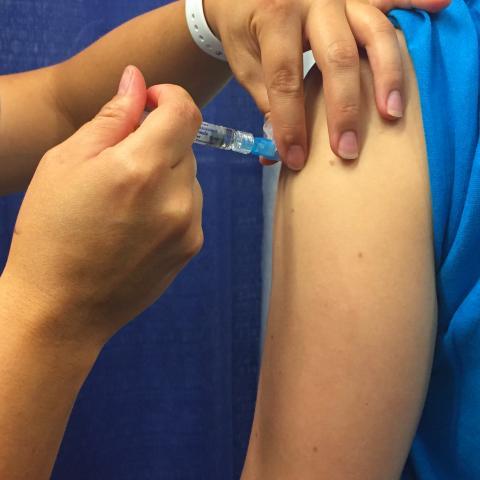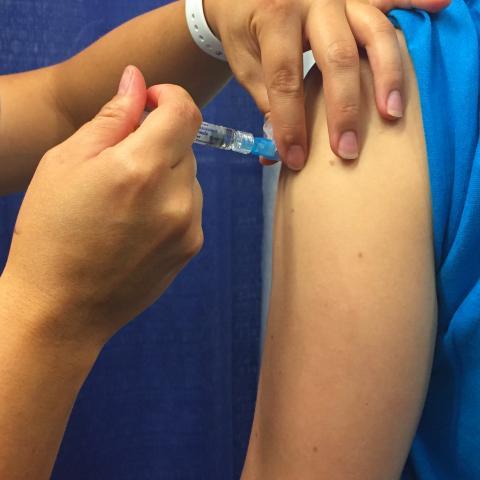
Credit: NIAID
PHILADELPHIA – Influenza A (flu A) hijacks host proteins for viral RNA splicing and blocking these interactions caused replication of the virus to slow, according to new research published in Nature Communications by Kristin W. Lynch, PhD, chair of the department of Biochemistry and Biophysics in the Perelman School of Medicine at the University of Pennsylvania, and doctoral student Matthew Thompson. Their results also suggest that infection with flu A may reduce splicing of some host genes, which could point to novel strategies for antiviral therapies.
Influenza A virus is a common human pathogen that causes 250,000 to 500,000 deaths per year worldwide. "Although vaccines and some antiviral drugs are available, it is crucial to understand influenza virus-host interactions at a molecular level in order to identify host vulnerabilities targeted by flu viruses, which could lead to developing new therapeutic options," said Lynch, whose lab focuses on the specific mechanisms and patterns of alternative RNA splicing and how it relates to human disease,
The transcription of DNA into messenger RNA – the process of a single gene encoding a single protein – isn't as straightforward as once thought. The phenomenon of alternative RNA splicing – where a single gene can encode multiple proteins – was discovered over 30 years ago in viruses.
The flu A genome is comprised of eight single-strand segments of RNA. Three of these segments use alternative splicing to produce two essential viral proteins each, which are important in helping the virus gain entry into host cells. Working with cultures of human lung cells, the team's proposed mechanism of how flu A virus interacts with human RNA splicing machinery suggests that keeping human splicing proteins from binding to the viral genome would help to stop its replication.
As a result, the researchers found that mutating sequences of the viral genome to prevent host proteins from binding caused viral RNA to splice incorrectly and eventually halt replication–thus slowing the spread of the virus in the body.
A balance between the two viral messenger RNAs must be maintained for the virus to successfully infect host cells and replicate. "Regulating splicing of the two viral proteins is a fundamental step in viral-host interaction and so a potentially new anti-viral remedy," Lynch said.
For now, her team is refining their understanding of the intricacies of viral reproduction in host cells. Their hope is to one day identify a specific molecular target for antiviral medications that can be used in the clinic.
###
This research was funded by the National Institutes of Health (R01AI125524, R35GM118048, HHSN272201400008C, U19AI10675, 4R33AI119304-03).
Penn Medicine is one of the world's leading academic medical centers, dedicated to the related missions of medical education, biomedical research, and excellence in patient care. Penn Medicine consists of the Raymond and Ruth Perelman School of Medicine at the University of Pennsylvania (founded in 1765 as the nation's first medical school) and the University of Pennsylvania Health System, which together form a $7.8 billion enterprise.
The Perelman School of Medicine has been ranked among the top medical schools in the United States for more than 20 years, according to U.S. News & World Report's survey of research-oriented medical schools. The School is consistently among the nation's top recipients of funding from the National Institutes of Health, with $405 million awarded in the 2017 fiscal year.
The University of Pennsylvania Health System's patient care facilities include: The Hospital of the University of Pennsylvania and Penn Presbyterian Medical Center — which are recognized as one of the nation's top "Honor Roll" hospitals by U.S. News & World Report — Chester County Hospital; Lancaster General Health; Penn Medicine Princeton Health; Penn Wissahickon Hospice; and Pennsylvania Hospital – the nation's first hospital, founded in 1751. Additional affiliated inpatient care facilities and services throughout the Philadelphia region include Good Shepherd Penn Partners, a partnership between Good Shepherd Rehabilitation Network and Penn Medicine, and Princeton House Behavioral Health, a leading provider of highly skilled and compassionate behavioral healthcare.
Penn Medicine is committed to improving lives and health through a variety of community-based programs and activities. In fiscal year 2017, Penn Medicine provided $500 million to benefit our community.
Media Contact
Karen Kreeger
[email protected]
215-459-0544
@PennMedNews
http://www.uphs.upenn.edu/news/
Related Journal Article
http://dx.doi.org/10.1038/s41467-018-04779-4





